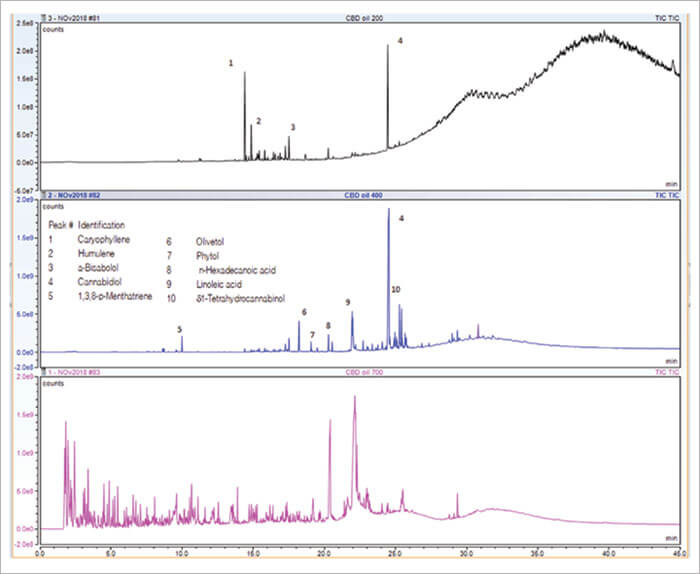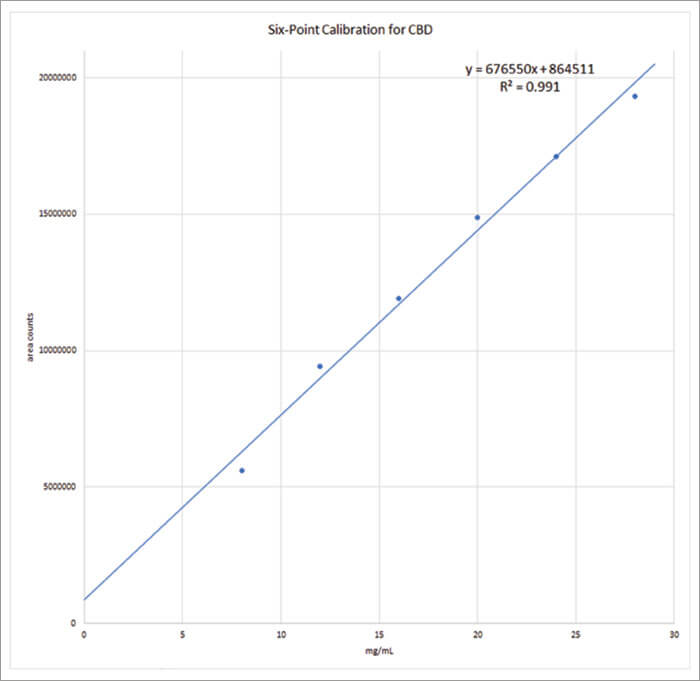This application note demonstrates multi-step analysis of CBD oil, along with a reproducibility study and a cannabidiol calibration curve on concentration.
Cannabidiol (CBD) oil, from the cannabis plant, is being credited for helping treat many medical issues and has gained interest in nutraceutical and pharmaceutical industries. Analytical testing using the CDS Pyroprobe can both qualify ingredients in CBD oil and quantify analytes.
A 500 μg quantity of CBD oil was first screened with a multi-step temperature sequence of 200°C, 400°C, and then 700°C on a CDS 6000 Series Pyroprobe to reveal specific active compounds including sesquiterpenes α-Bisabolol, α-Caryophyllene, and cannabinoids (CBD and δ9-Tetrahydrocannabinol) (Figure 1).
After choosing 300°C as a thermal extraction temperature for CBD, a reproducibility test was performed. Five 0.5μL aliquots of CBD oil diluted in half with hexane (for easy syringe additions) were each run at a setpoint of 300°C for 30 minutes. Replicate chromatograms are shown in Figure 2; area counts yield an RSD of 2.18 percent.

After confirming the reproducibility, a CBD calibration curve was created by running 4, 6, 8, 10, 12, and 14 μg of a CBD standard, equivalent to concentrations of 8, 12, 16, 20, 24, and 28mg/mL from a sample with fixed volume of 0.5μL. A linear regression with r2 >0.99 was observed, also shown in Figure 3. By comparing the average area of the CBD in the replicates in relation to the calibration curve, it was determined that the sample has 24mg/ mL of CBD. As the sample was diluted in half, the original CBD oil has 48mg/ mL of CBD, close to what was claimed by the manufacturer (50mg/mL).
Experimental Parameters
Samples were pyrolyzed in a DISC tube, using a CDS Model 6200 Pyroprobe.
6200 Pyroprobe
Mode: Trapping
DISC Final: 300°C hold 20min
Trap Rest: 50°C
Trap Final: 300°C 10min
Interface: 300°C
Oven: 300°C
Transfer line: 300°C
GC/MS
Column: 5 percent phenyl, (30m x 0.25mm)
Carrier: Helium, 50:1 split
Injector: 320°C
Oven: 80°C for 10 minutes, 10°C/min to 300°C
Ion Source: 230°C
Mass Range: 35-600amu







